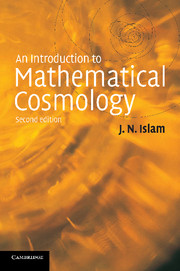Book contents
- Frontmatter
- Contents
- Preface to the first edition
- Preface to the second edition
- Dedication
- 1 Some basic concepts and an overview of cosmology
- 2 Introduction to general relativity
- 3 The Robertson–Walker metric
- 4 The Friedmann models
- 5 The Hubble constant and the deceleration parameter
- 6 Models with a cosmological constant
- 7 Singularities in cosmology
- 8 The early universe
- 9 The very early universe and inflation
- 10 Quantum cosmology
- 11 The distant future of the universe
- Appendix
- Bibliography
- Index
Preface to the second edition
Published online by Cambridge University Press: 03 February 2010
- Frontmatter
- Contents
- Preface to the first edition
- Preface to the second edition
- Dedication
- 1 Some basic concepts and an overview of cosmology
- 2 Introduction to general relativity
- 3 The Robertson–Walker metric
- 4 The Friedmann models
- 5 The Hubble constant and the deceleration parameter
- 6 Models with a cosmological constant
- 7 Singularities in cosmology
- 8 The early universe
- 9 The very early universe and inflation
- 10 Quantum cosmology
- 11 The distant future of the universe
- Appendix
- Bibliography
- Index
Summary
The material in the earlier edition, to which there appears to have been a favourable response, has been kept intact as far as possible in this new edition except for minor changes. A number of new additions have been made. Some standard topics have been added to the introduction to general relativity, such as Killing vectors. Not all these topics are used later in the book, but some may be of use to the beginning student for mathematical aspects of cosmological studies. Observational aspects have been brought up to date in an extended chapter on the cosmological constant. As this is a book on mathematical cosmology, the treatment of observations is not definitive or exhaustive by any means, but hopefully it is adequate. To clarify the role of the cosmological constant, much discussed in recent years, an exact, somewhat unusual solution with cosmological constant is included. Whether the solution is new is not clear: it is meant to provide a ‘comprehension exercise’. One reviewer of the earlier edition wondered why the Hubble constant and the deceleration parameter were chosen for a separate chapter. I believe these two parameters are among the most important in cosmology; adequate understanding of these helps to assess observations generally. Within the last year or two, through analyses of supernovae in distant galaxies, evidence seems to be emerging that the universe may be accelerating, or at least the deceleration may be not as much as was supposed earlier.
- Type
- Chapter
- Information
- An Introduction to Mathematical Cosmology , pp. xi - xiiPublisher: Cambridge University PressPrint publication year: 2001

